
The 10 Iconic Symbols of Chinese Culture & Their Meanings
In today’s article, we will explore a fascinating aspect of Chinese culture – its symbols. These symbols are more than just cool images decorating objects, buildings, and clothes: they're like little ambassadors of the culture, each carrying stories, beliefs, and Chinese history.
By reading this article, you can spot and understand Chinese symbol meanings. You'll also find a useful vocabulary table at the end of the article.
Chinese animal symbols
Animals often hold special places in cultures worldwide, and China is no exception.
1. Dragon (龙 – lóng)
One of the most iconic Chinese symbols is the dragon. The dragon symbol demonstrates power, strength, and good luck. Chinese dragons are believed to bring rain for crops and protect against disasters. In ancient times, it was also a symbol for the emperor.
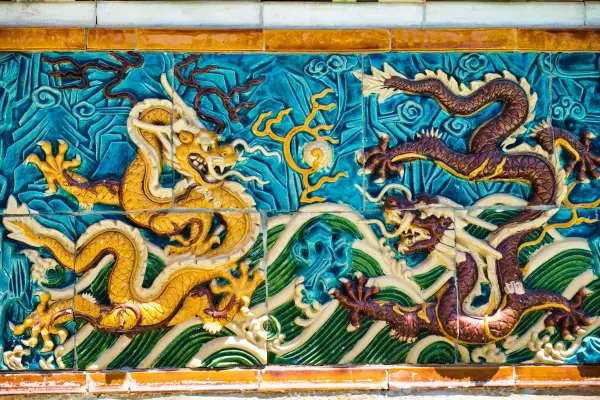
Dragons on Chinese tiles
In ancient China, the emperor was an embodiment of the supreme dragon. To emphasize this association, Chinese emperors often wore silk robes with beautifully embroidered dragon motifs (the so-called "Dragon Robes," 龙袍 – lóngpáo); they sat on a throne carved with dragon forms, and the emperor’s palace was adorned with architectural decorations of dragons. If you plan on visiting the Forbidden City in Beijing, you’ll be able to see a lot of dragons. The Chinese dragon associated with the emperor always had five claws to distinguish it from ordinary dragons, which had only four.
Additionally, there are many dragon decorations all over Chinese temples, ancient buildings, and part of the Chinese zodiac despite the rest of the animals being normal.
2. Phoenix (凤凰 – fènghuáng)

Phoenix bronze statue
In Chinese culture, the phoenix isn't just a mythical creature; it symbolizes the supreme virtues of harmony and balance.
It's the perfect counterpart to the dragon's power. While the dragon symbolizes the emperor's authority, the phoenix embodies the empress's compassion and virtue, creating a harmonious duality for effective rule.
Beyond its regal associations, the phoenix carries themes of renewal and resilience, and it's a symbol of power. According to the legend, this bird can rise from its ashes: that’s why the phoenix embodies the idea of triumph over adversities and constant renewal. In weddings, it represents the bride, embodying strength and grace.
From ceremonial robes to art and architecture, the phoenix is one of Chinese culture's most popular and important symbols.
3. Panda (大熊猫 – dà xióngmāo)
The panda holds a special place in the hearts of Chinese people as it's one of the most popular symbols of Chinese culture. This cute native animal in China is often associated with harmony, peace, and friendship. Pandas were chosen as "China's national treasures" because the black and white fur reminds people of the balance between Yin and Yang, a key concept in Chinese philosophy.
Pandas have also been used in Chinese diplomacy as an instrument of soft power: China has often gifted pandas to other countries as a sign of goodwill and friendship.
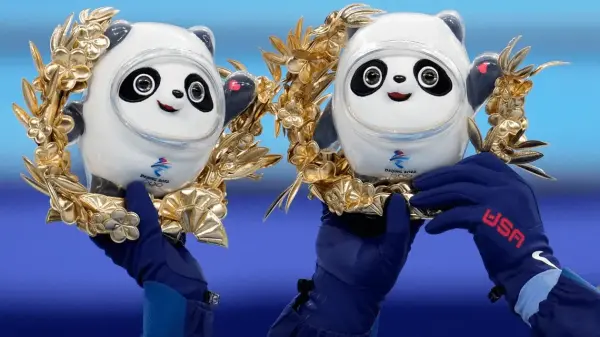
Mascots at the 2022 Beijing Winter Olympic Games | WFMY News
Because of all these reasons, in recent years, the Chinese government has made significant strides in panda conservation and has established a network of protected areas to help increase the population of this endangered species; the biggest and most popular one is in Chengdu. These Panda reserves make them one of the coolest places to visit as they attract many tourists every year, and if you are planning on visiting China, seeing pandas in natural reserves is a wonderful experience, much better than zoos.
4. Magpie (喜鹊 – xǐquè)
While in some Western countries, the magpie is considered a bad omen, in China, it is considered an auspicious bird. In the eyes of the Chinese, it is a symbol of joy, happiness, and good fortune.
There is a common saying in Chinese, "喜鹊叫,喜事到" (Xǐquè jiào, xǐshì dào), meaning "If the magpie sings, something good is coming". Chinese people often include the image of the magpie in good luck decorations. You can find it in cut-out cards for windows and traditional Chinese paintings, and it can also appear with other elements, forming new auspicious motifs.
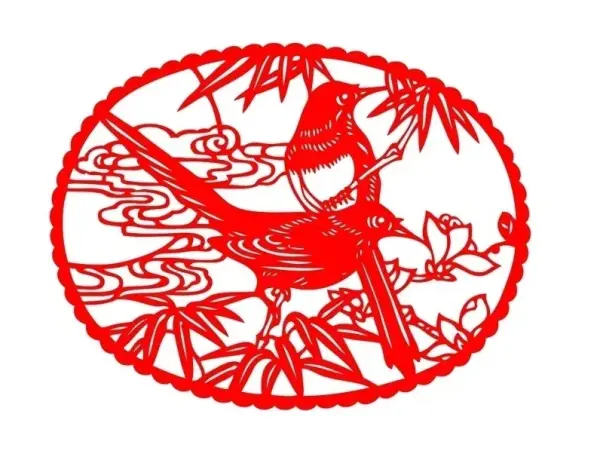
Chinese paper cutting with magpies | Sucaisucai
Now that you know the magpie is one of the most popular Chinese auspicious symbols, the next time you see one, don't worry because maybe good luck is coming.
Chinese plant symbols
Now, let's move on to the plant world, with the two most important Chinese symbolic plants.
5. Lotus Flower (荷花 – hé huā):
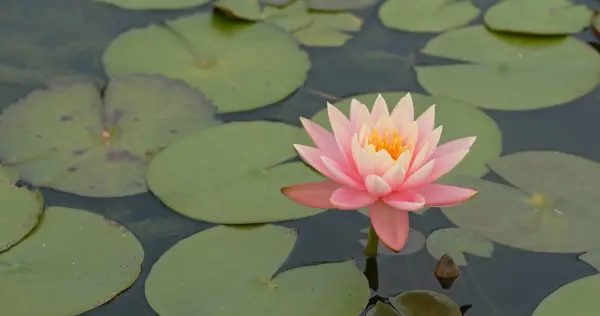
The lotus flower, known as "荷花" (hé huā) in Chinese, holds a special place in Chinese culture.
It symbolizes strength and resilience against adversities, as this plant grows from the mud at the bottom of ponds and rises above the water's surface to bloom. The lotus flower, with its clean, delicate, and beautiful appearance, is a powerful emblem of moral purity and spiritual awakening. Not only for its beauty, lotuses were also used in traditional Chinese medicine.
"出水芙蓉" (chū shuǐ fú róng) is a Chinese idiom that literally translates to "lotus emerging from the water." It describes newly bloomed lotus flowers, which are fresh and unsullied. Figuratively, this idiom is used to compliment poetry or prose that is elegant and refined, as well as to describe a naturally beautiful woman. It conveys the idea of something pure and exquisite, much like a lotus emerging from the water.
6. Bamboo (竹子 – zhú zi):
Bamboo, or "竹子" (zhú zi), is highly esteemed in traditional Chinese culture for its strength, flexibility, and resilience. Bamboo's ability to bend but not break in the face of adversity is a metaphor for a person's ability to adapt to challenging circumstances; that's why bamboo has become a symbol of integrity and tenacity.
In rural Chinese villages, bamboo is used to make paper and utensils and cook rice. Here is a photo of me in a village near Guilin cutting a piece of bamboo:

Author Elisa cutting bamboo
The chengyu 胸有成竹 (xiōng yǒu chéng zhú), "to have a finished bamboo in mind," means to plan and prepare in advance. Learn about the story behind this Chinese saying with the video below.
Quick Chinese Idioms’ Well prepared and confidentObject/ideas symbolism in Chinese culture
7. Yin (阴 – Yīn) and Yang (阳 – Yáng)

At the heart of Chinese philosophy, and more specifically, of Taoist philosophy, lies the concept of Yin and Yang, represented by the Chinese characters 阴 (Yīn) and 阳 (Yáng). This fundamental duality symbolizes the interdependence of opposing forces in the universe: while Yin embodies qualities such as darkness, passivity, and the moon, Yang is associated with light, activity, and the sun. These two opposite forces are inseparable, and they are believed to be found everywhere: together, they form a harmonious balance, the preservation of which is central to various aspects of Chinese thought, from traditional medicine to martial arts.
8. Feng Shui (风水 – Fēng Shuǐ)
You have probably heard of feng shui before, and you may have tried rearranging the furniture in your room to adhere to its rules. Feng shui is the art of arranging objects and spaces in harmony with nature so that energy, or qi in Chinese, can flow freely. This symbolic concept of Chinese philosophy is believed to increase people's health and well-being and is now widespread worldwide.
9. Double gourd (葫芦 – húlú)
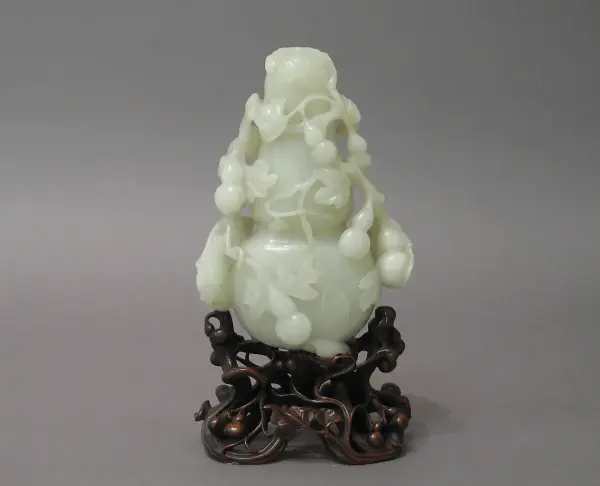
Bottle in the shape of a gourd | Met museum
In China, double gourds have a symbolic meaning. They are closely connected with the concepts of time, universality, regeneration, and emptiness.
Double gourds are associated with fertility rites and social harmony, reflecting the importance of love and patience within families and communities. In Chinese weddings, gourd-shaped wine containers symbolize the union between husband and wife, emphasizing the theme of procreation and continuity. Double gourd representations in ceramics and art embody the eternal time of the celestial world, untouched by earthly limitations.
Ultimately, the gourd is a powerful metaphor for the interconnectedness of life, the importance of social relations, and the beauty of emptiness in Chinese culture.
10. Chinese knot (中国结 – Zhōngguó Jié)

Close up of Chinese knot
Chinese knots represent the interdependence of all things and the cyclic nature of existence. Their unbroken lines symbolize eternal love, compassion, and the endless cycle of birth, life, death, and rebirth.
Nowadays, Chinese knots are mainly used to decorate interiors, as gifts to family and friends, and as personal accessories. Due to their symmetrical and refined appearance, they successfully represent China's long history and conform to the customs and aesthetic concepts of traditional Chinese decoration.
Chinese knots are not only aesthetically beautiful because of their shape and flashy colors. These little masterpieces also carry good wishes, blessings, and prayers.
The remarkable peculiarity of the Chinese knot is that it is worked from start to finish with a single thread. Each knot is named after its shape and meaning. Different knot decorations can be combined, or other auspicious motifs can be used to form a unique, colorful, deep meaning and rich connotation of traditional Chinese auspicious decorations.
BONUS: Vocab table
Below is a table with the Chinese characters and pinyin of the most popular symbols to help you remember them.
I hope you enjoyed learning about the most popular and culturally significant Chinese symbols!
Chinese Character |
Pinyin |
Translation |
龙 |
lóng |
Dragon |
龙袍 |
lóngpáo |
Dragon Robe |
凤凰 |
fènghuáng |
Phoenix |
大熊猫 |
dà xióngmāo |
Panda |
喜鹊 |
xǐquè |
Magpie |
荷花 |
hé huā |
Lotus Flower |
竹子 |
zhú zi |
Bamboo |
阴 |
Yīn |
Yin |
阳 |
Yáng |
Yang |
风水 |
Fēng Shuǐ |
Feng Shui |
葫芦 |
húlú |
Double gourd |
中国结 |
Zhōngguó Jié |
Chinese knot |
Frequently asked questions
What are powerful symbols in Chinese culture?
The dragon and the phoenix are powerful symbols in Chinese culture. The dragon symbols are prominent in traditional Chinese culture as they symbolize power and strength. The phoenix is the perfect balance with the dragon as they symbolize harmony and virtue.
What is the sacred symbol of China?
The dragon can be considered as a sacred symbol in China as it is deeply intertwined with Chinese culture and history. Often associated with imperial power and the emperor, dragons are seen with power, strength, and luck. Despite being mythical creatures, they are also symbols of the natural world to bring rain and protection from disasters.
What symbolizes love in Chinese culture?
The Chinese knot is one of the physical object symbols that represents love in Chinese culture. They symbolize longevity and eternity, the perfect object to show your love.
To summarize
What do you think of these iconic symbols of Chinese culture? These iconic symbols of Chinese culture are not decorative elements but hold deep historical beliefs and stories. Let these symbols become a part of your Chinese language journey.
Elisa Felici has been studying Chinese since 2014. She started her language-learning journey at Italian universities and lived in Beijing while attending Beijing’s Confucius Institute. Elisa passed HSK 4 and 5 and finally, in 2020, HSK 6. She now has a Master’s degree in translation and interpreting and has experience not only as a language learner but also as a Chinese teacher and translator.
The easiest way to learn Chinese & build vocabulary

